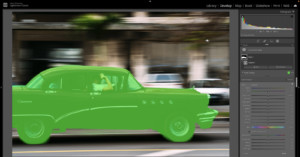
Lightroom on Android Now Supports Ultra HDR Photo Editing
Lightroom on Android got a major update which adds support for Ultra HDR image editing.

Lightroom on Android got a major update which adds support for Ultra HDR image editing.

Adobe has announced significant new features for Adobe Lightroom at Adobe MAX 2023. "We're excited to unveil a range of innovative Lightroom features that make it easier than ever to express your creative vision, now with more choice over where your images are stored," says Adobe.

In his latest video, landscape photographer Michael Shainblum shares five of his favorite techniques for using Adobe Lightroom's powerful masking tools.

Following Adobe's announcement last week of new artificial intelligence (AI) innovations in its video editing applications, Premiere Pro and After Effects, Adobe has announced that its widely used photo editing Lightroom applications will be receiving new AI-powered updates.

A photographer has built himself a DIY macro pad for Adobe Lightroom after not being able to afford a Loupedeck.

Lightroom preset developer DVLOP and SLR Lounge have partnered to release Impossible Things, an artificial intelligence-powered (AI) photo editor that works natively inside of Adobe Lightroom.

In early January, Adobe came under fire for language used in its terms and conditions that seemed to indicate that it could use photographers' photos to train generative artificial intelligence systems. The company has reiterated that this is not the case.

Adobe has added a "Content Analysis" section to its privacy and personal data collection permissions that, unless opted out of, opens photographers' images to being used to train the company's artificial intelligence and machine learning models.

Social media users have been left amazed by the sight of a World Cup photographer using his trackpad to quickly edit pictures of Cristiano Ronaldo.

Color Grading in Lightroom is a lot of fun, but for beginners, it can be a bit overwhelming. This often leads to people thinking you need to adjust all the sliders there are, but often this just leads to a strange-looking photo.

A photographer has revealed what his original images look like when he takes them compared to the final, spectacular edited result.

Adobe has announced new additions to the Lightroom suite, including AI-powered masking and better Adaptive Presets, which the company says will be rolling out to users this week.

Darktable, an open-source answer to Adobe Lightroom, has announced a major update to version 4.0 which adds a massive list of changes, new features, and bug fixes including new color science tools and a totally new user interface.

I recently heard a photographer say he’d spent 17 hours going through 10,000 images, deciding which ones were worth saving. My first thought was, “I hope he’s retired.” My second thought, though, was that he badly needed a lesson on speeding up his workflow. Which led me to write this guide on how to turbocharge your photography workflow.

Travel photographer and content creator Pat Kay has released an extensive and detailed video on how to edit a digital image in Adobe Lightroom to make it look as though it was captured on film.

Photoshop and Lightroom are mainstays in most photographers’ workflows for a reason. While other options abound, no other set of programs matches the popularity and widespread adoption of Adobe’s signature photography software. But while Photoshop’s manipulation capabilities and Lightroom’s processing and editing power are certainly robust, both offer even more power beyond the software itself in the form of plugins.

Luke Stackpoole is a London-based landscape photographer and Adobe Lightroom Ambassador who has traveled around the world in search of dramatic scenery. From the barren deserts of Namibia to the frigid seascapes of Iceland, Stackpoole has amassed a stunning portfolio that shows the world’s most dreamlike landscapes.

Buying a copy of Photoshop back in the day wasn’t cheap, but it used to be easy. One price, one copy. Nowadays, with subscription models dominating the creative software space, things have gotten a bit more complicated. And while photographers may need a bingo card to know how much Photoshop is going to cost, there are a lot more benefits than swinging down to the local computer store and picking up a copy.

Adobe has announced that its annual creativity conference, MAX, is returning to in-person this year after two years of virtual-only shows that came about due to the coronavirus pandemic.

London-based photographer Alixe Lay specializes in capturing interiors and infusing them with an ethereal spirit through her signature style.

The meaningful impact of cloud computing with respect to photo editing was an amorphous topic when it was first introduced to photographers in 2013. Nearly a decade later, that has changed and two of the biggest companies in the editing space show how it can be leveraged to support photographers differently.

When Lightroom CC originally launched it was woefully behind Classic from a features perspective. Photographers who had come to expect certain tools and performance were greeted with an underpowered CC, and few gave it a second glance after that. But now, nearly five years later, those same photographers might not know that they are nearly identical now. So then, why do we have two versions of the same software?

One of the most exciting advancements in digital photography over the last several years has been the rapid increase in the ability to shoot and edit RAW photos.

Galeryst.com enables Adobe Lightroom users to create 3D virtual online art galleries to share their art. There are paid tiers, but photographers can make an 80-photo digital gallery for free.

From importing, to organizing, to the editing process itself, few tools have the capacity to define a photographer’s workflow like Adobe’s Lightroom. Of the program’s many indispensable features, the ability to create user presets ranks quite high: it offers photographers the ability to lock in preferred looks, adjustments, and settings for rapid implementation across multiple images. Better still, these presets are readily shareable, allowing users easy access to the settings required for virtually any desired result without going through the hassle of creating them themselves.

It’s not often that a new Lightroom update or feature is as positively received by users as last week’s Masking improvements. And there is a good reason for the fanfare because these new tools really are amazing... as well as a bit confusing and inconsistent.

Unless you’ve just emerged from a nuclear fallout bunker, you’ve likely already heard about Lightroom’s impressive new masking tools that Adobe announced at their annual Adobe Max conference. In fact, PetaPixel’s Ryan Mense wrote a wonderful hands-on article covering the expanse of these new masking tools.

In a new update, Adobe is greatly increasing the masking capabilities of its Lightroom applications as well as Adobe Camera RAW. While it is not as powerful as what is found in full-fledged Photoshop, you will find yourself wondering how you ever lived without it.

Don’t toss a photo just because the lighting isn’t the best. You may be able to bring it back alive in post-production. As photographers, we face countless different scenarios and it's nearly impossible to get the perfect shot 100% of the time.

Even though the Brush tool is not a new tool in Adobe Lightroom, you may be surprised by all the ways it can be used and all the advantages you can gain by using a brush. This is part of my daily workflow and I hope it will become part of yours!

In its annual tradition, Adobe has announced a list of talented and extraordinary photographers who have been named as 2021 Adobe Rising Stars of Photography. One of them, Anna Neubauer, has shared her insight on what it means to her and how she breaks away from industry stereotypes with her photography.

Adobe has teamed up with prominent photographers who are experienced in photographing subjects with darker skin tones to release a set of free presets that aim to deliver more naturally calibrated photos of all skin complexions.

After a year indoors, this year’s Fourth of July fireworks are sure to be one of the highlights of summer. As most photographers know, the bright flash from fireworks against the dark night sky can make it tricky for both novice and experienced photographers to get a crystal-clear image of the spectacle.

DxO's new Nik Collection 4 comes with several new features and upgrades but still retains the familiar workflow and film simulations fans are looking for. The subtle changes make for an easy transition for long-time users and are bound to attract new interested photographers, too.

We are all likely familiar with Adobe Lightroom or Photoshop as far as editing applications go and a lot of people love these apps for their versatility and powerful suite of features. But they do come with a price, and paying a fee isn't always what every photographer is looking for.

In its latest development build, Microsoft has added support for HDR in Windows 10 which will unlock access to the full gamut of colors in HDR displays in creative and artistic apps, including both Photoshop and Lightroom.

When Adobe first unveiled Super Resolution, it gave photos a chance to increase in size without losing any quality, but it wasn’t clear whether that kind of magic extended to the trove of images on people’s smartphones.

One of the most misunderstood tools in Adobe Lightroom is the Calibration tool. This is kind of a shame, because it's also one of the most powerful tools available to us as photographers, both from a correction perspective and a creative perspective.

For the past few years, I've been content with keeping my entire photo editing worldview pegged to the Adobe ecosystem. Anything that Lightroom couldn't handle, or that required more refined content-aware heavy-lifting, was offloaded to Photoshop. And that's the way things went for a very long time.

A few weeks ago, I was speaking with a good friend -- who is also a heck of a photographer -- about the pros and cons of using creative profiles and presets as part of your photo editing workflow. His stance was unambiguous and straightforward: as far as he’s concerned, profiles and presets are murderers of creativity.